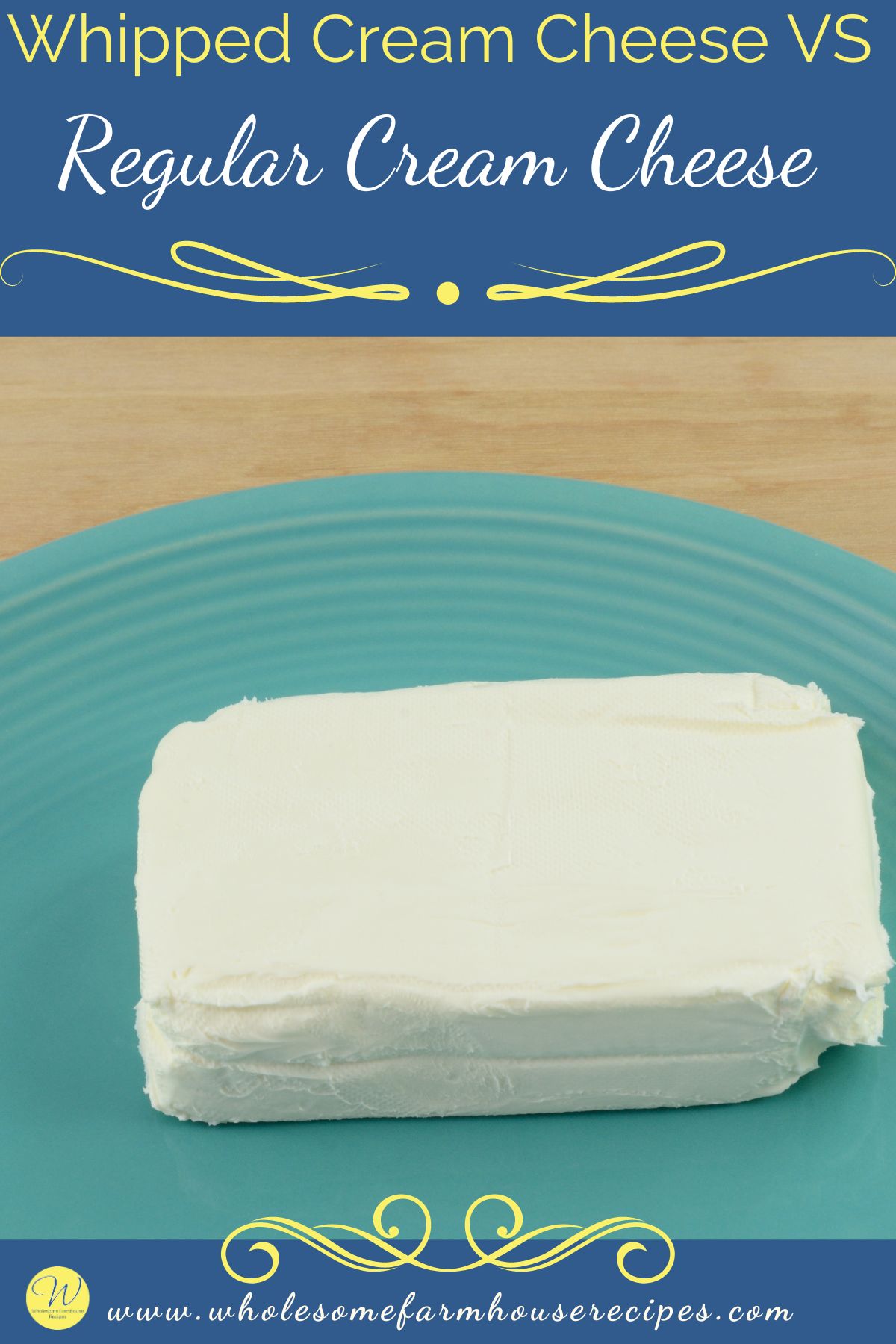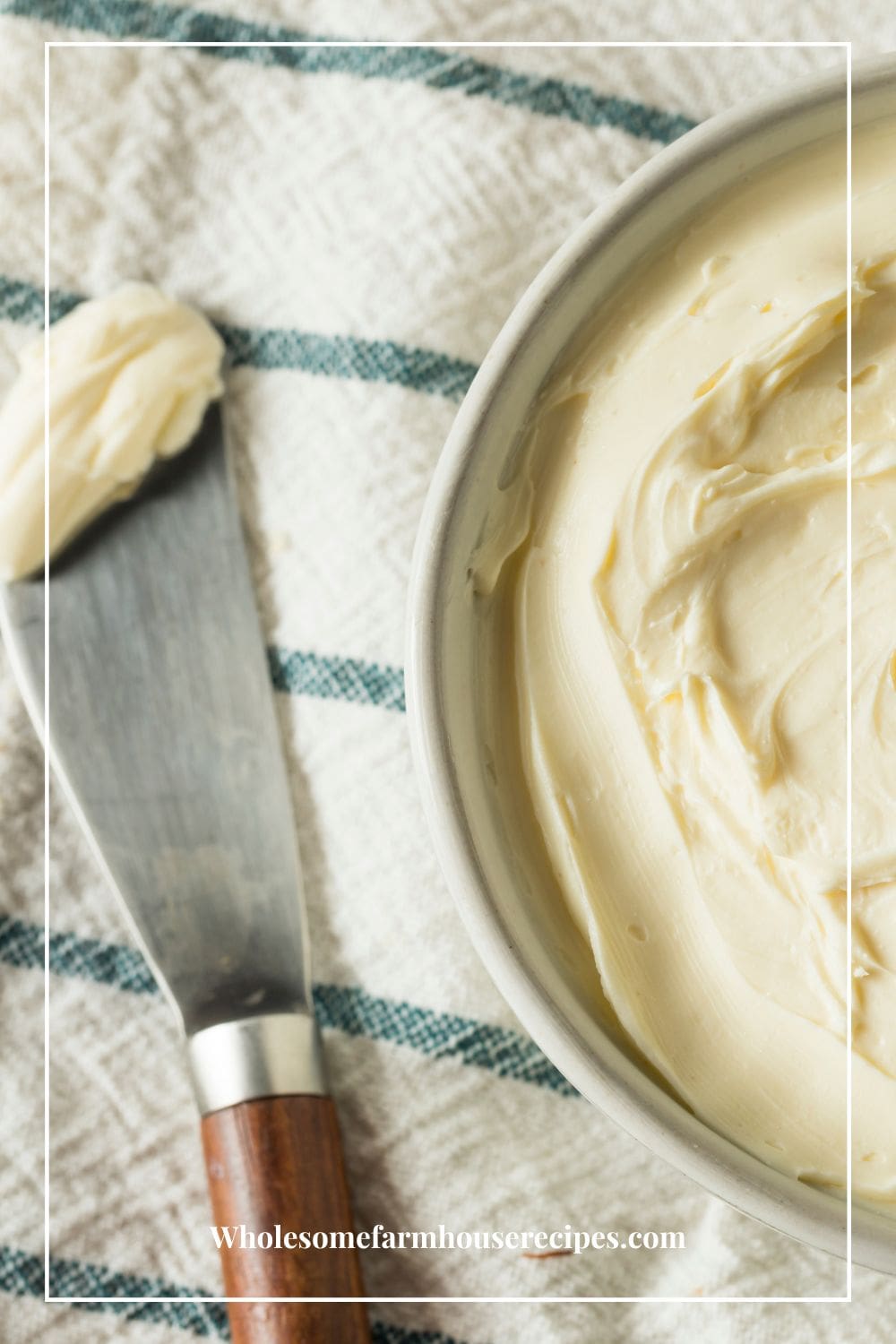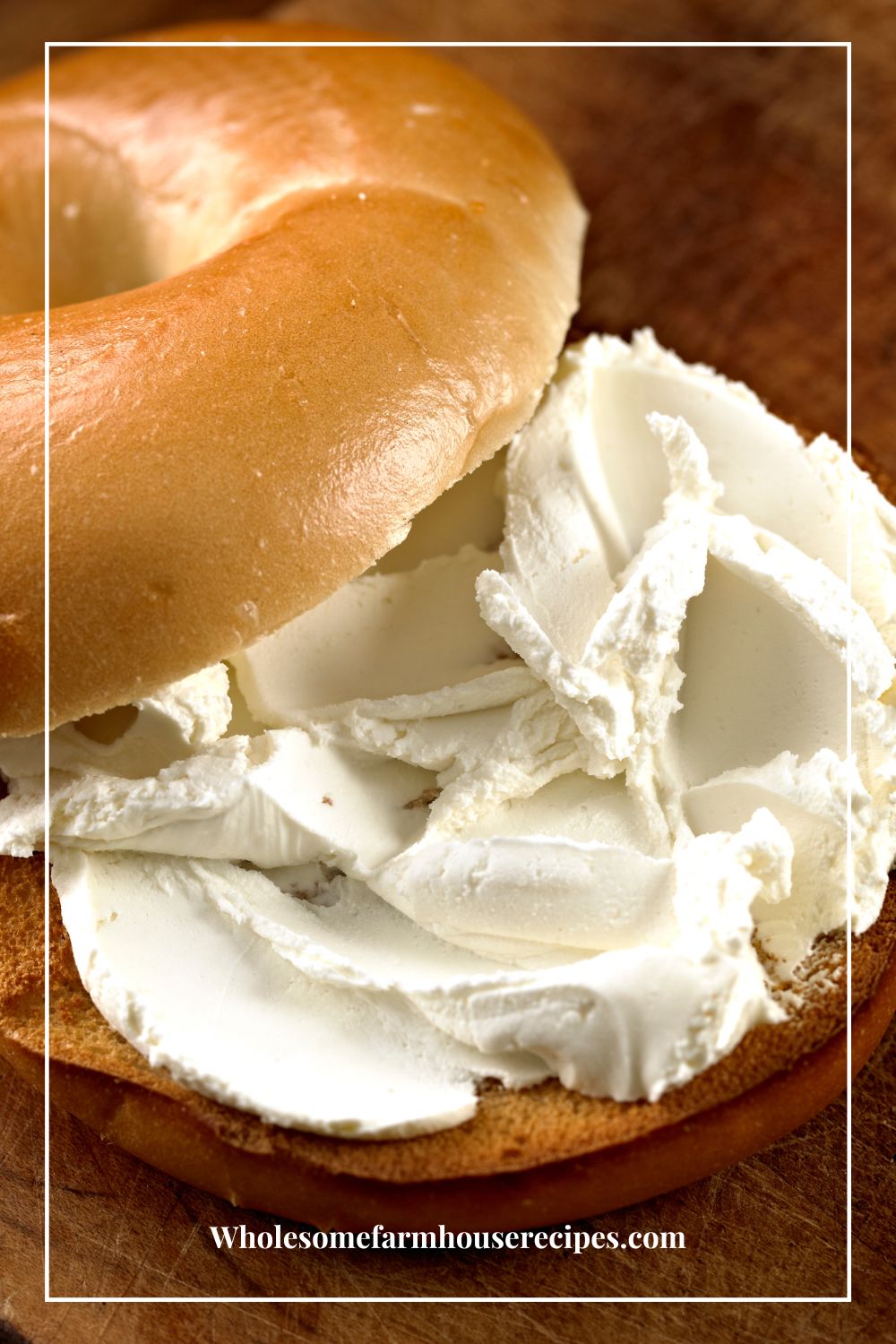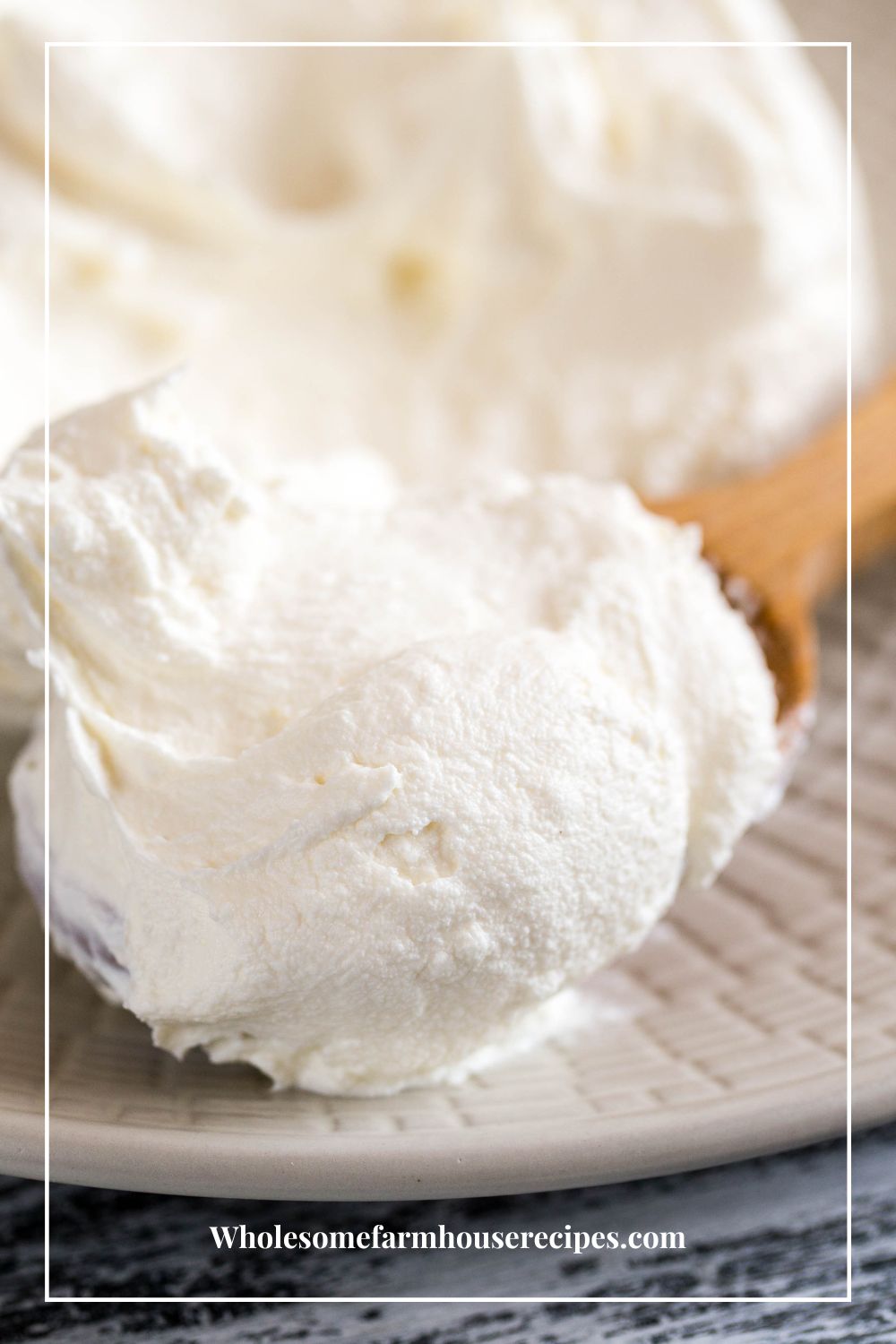Have you ever wondered what the difference is between whipped cream cheese vs regular cream cheese? Cream cheese is a staple ingredient in many recipes, from cheesecake to frosting to dips. Let’s explore the differences between these two types of cream cheese and answer some common questions about their uses and substitutions.
Homemade Cream Cheese Recipe
There’s nothing quite like the creamy, tangy flavor of homemade cream cheese. With just a few simple ingredients and a little patience, you can make your own delicious cream cheese right at home.
We have a homemade version for you to make that is budget friendly and delicious.
This recipe uses milk and lemon juice or white vinegar to create a smooth and creamy texture that’s perfect for spreading on bagels, toast, or using in your favorite recipes.
Best of all, it’s completely customizable, so you can add your own flavors and seasonings to create a cream cheese spread that’s uniquely your own.
Whether you’re looking for a healthier alternative to store-bought cream cheese or just want to try your hand at homemade dairy products, this recipe is the perfect place to start.

What is Whipped Cream Cheese?
Whipped cream cheese is simply regular cream cheese that has been whipped with air to create a lighter, fluffier, airy texture.
This process gives whipped cheese a smooth texture and more spreadable consistency. Therefore, it easier to use in recipes like dips and spreads. Whipped cream cheese is typically sold in a tub and is often flavored with herbs, spices, or fruits.

Can You Substitute Whipped Cream Cheese for Regular Cream Cheese?
In most recipes, you can substitute whipped cream cheese for regular cream cheese without any issues.
However, whipped cream cheese is a type of cream cheese that contains more air and less solids than regular cream cheese. It may not hold up as well in recipes that require a thicker or denser consistency.
For example, if you are making a cheesecake or cream cheese frosting, it may be best to use regular block cream cheese to ensure the proper texture and consistency. However, they are both dairy and part of a healthy diet.
Is 8 oz Whipped Cream Cheese the Same as Regular Cream Cheese?
No, 8 oz of whipped cream cheese is not the same as 8 oz of regular cream cheese. The main difference is the way they are processed.
This is because whipped cream cheese contains more air and less solids than regular cream cheese. Therefore, the volume and weight of the two products will differ.
To ensure the proper amount of cream cheese in your recipe, be sure to measure by weight or use the appropriate amount based on the recipe instructions.
How much whipped cream cheese equals regular cream cheese?
If you need to substitute one for the other, you can use this general guideline. 1 cup of whipped cream cheese is roughly equivalent to about 1 1/2 cups of regular cream cheese.
Keep in mind that this is just a rough estimate, and the actual substitution may vary depending on the specific brands and products you’re using. It’s always a good idea to adjust based on the consistency and taste you’re looking for in your recipe.
Is Whipped Cream Cheese the Same as Heavy Cream?
No, whipped cream cheese is not the same as heavy cream. Heavy cream is a liquid dairy product that contains a high percentage of fat. Whereas whipped cream cheese is a solid dairy product that has been whipped with air to create a lighter texture.
The two products have different uses in recipes and cannot be substituted for each other.
Why is Whipped Cream Cheese Less Calories?
Whipped cream cheese is often marketed as a lower-calorie alternative to regular cream cheese. This is because the whipping process adds air to the cream cheese, which dilutes the calories per ounce.
Additionally, some brands of whipped cream cheese may contain fewer calories and less fat than regular cream cheese due to the addition of stabilizers or thickeners.
However, it’s important to check the nutrition labels of each product to determine the exact calorie and fat content.
In conclusion, while whipped cream cheese and regular cream cheese are similar in flavor and appearance, they have some key differences in texture, consistency, and use. Whipped cream cheese can be a great option for spreads and dips. However, it may not work as well in recipes that require a thicker consistency. When substituting whipped cream cheese for regular cream cheese, be sure to consider the recipe. Adjust as needed to achieve the desired results.

What is Neufchatel Cheese?
Neufchâtel cheese is a soft, unripened cheese that originated in the Neufchâtel-en-Bray region of Normandy, France. It is similar in texture and taste to cream cheese, but with a slightly lower fat content.
Neufchâtel cheese is typically made from cow’s milk, and has a slightly tangy flavor with a creamy texture.
It is commonly used in both sweet and savory dishes, and is often used as a spread for bagels, crackers, and sandwiches. It can also be used in recipes such as cheesecake, dips, and sauces.
In the United States, Neufchâtel cheese is often sold as a lower-fat alternative to cream cheese. Although the two cheeses are not exactly the same.
While both Neufchâtel cheese and cream cheese are soft, unripened cheeses that can be used interchangeably in many recipes. Neufchâtel cheese typically has a lower fat content (about 23-33% versus 33-55% for cream cheese) and a slightly different flavor profile.

Does Cream Cheese Have Lactic Acid?
Yes, cream cheese does contain lactic acid. Lactic acid is a natural byproduct of the fermentation process that occurs when milk is converted into cheese and other dairy products.
Cream cheese is made by adding a starter culture of lactic acid bacteria to milk. This causes the milk to acidify and thicken.
The resulting curd is then drained, salted, and mixed with cream to create the smooth, spreadable texture of cream cheese. The lactic acid in cream cheese gives it a slightly tangy flavor. It helps to preserve it by inhibiting the growth of harmful bacteria.
How Come I get Sick from the Lactic Acid in Milk but Not in Cheese?
It’s unlikely that you are getting sick from lactic acid in milk or cheese. Lactic acid is a naturally occurring compound in both of these dairy products. It is generally considered safe for human consumption. In fact, lactic acid is often used as a food preservative and flavoring agent in a variety of foods.
However, some people may be sensitive to lactose, which is a sugar found in milk and milk products.
Lactose intolerance occurs when the body is unable to properly digest lactose. This can lead to symptoms such as bloating, gas, and diarrhea.
Cheese, on the other hand, typically has a lower lactose content than milk> Much of the lactose is removed during the cheese-making process. As a result, some people with lactose intolerance may be able to tolerate cheese better than milk.
It’s also possible that the symptoms you are experiencing after consuming milk are due to an allergy or intolerance to another component of milk, such as casein or whey protein, rather than the lactic acid itself.
If you are experiencing symptoms after consuming dairy products, it’s best to consult with a healthcare professional to determine the underlying cause and determine the best course of action.
Does This Cheese Have Saturated Fat?
Yes, cream cheese does contain saturated fat. Saturated fat is a type of fat that is solid at room temperature and is often found in animal products, including dairy products like cream cheese.
The amount of saturated fat in cream cheese can vary depending on the brand and type. Generally, cream cheese is considered to be a high-fat food.
According to the USDA, one ounce (28 grams) of cream cheese contains approximately 9 grams of total fat, of which 6 grams are saturated fat. This represents about 30% of the daily values recommended limit for saturated fat intake for an average adult on a 2000 calorie per day diet.
While it’s important to monitor your intake of saturated fat as part of a healthy diet, it’s also worth noting that cream cheese can be a good source of nutritional value. It has protein and calcium. It’s all about finding a balance and incorporating cream cheese into your diet in moderation.

Do you Need Cheese Culture for Making Cream Cheese?
Yes, cheese culture is typically used when making cream cheese. Cheese culture refers to a specific blend of bacteria that are added to milk to help ferment and acidify it. This is a necessary step in the cheese-making process.
The bacteria used in cheese culture can vary depending on the type of cheese being made. For cream cheese, a blend of lactic acid bacteria is commonly used.
The addition of cheese culture to milk is what causes it to thicken and form curds. They are then drained and mixed with cream to create the smooth, spreadable texture of cream cheese.
Without the addition of cheese culture, the milk would not acidify properly and would not form curds, resulting in a product that is not true cream cheese.
That being said, it is possible to make cream cheese without using a commercial cheese culture. The necessary bacteria can be naturally present in the environment or in the milk itself. However, using a cheese culture is the most reliable and consistent method for making high-quality cream cheese.
Homemade Cream Cheese Recipe
As an Amazon Associate I earn from qualifying purchases.
Kitchen Essentials
Ingredients
- 1 Quart Milk whole milk is preferred, but you can use any milk with at least 2% fat
- 1/4 Cup Fresh Lemon Juice or white vinegar
- Salt optional
Instructions
- Heat the milk in a large pot over medium heat, stirring occasionally, until it reaches a temperature of 165-170°F.
- Remove the pot from the heat and slowly stir in the lemon juice or white vinegar. Keep stirring until the milk starts to curdle and separates into curds and whey.
- Allow the mixture to cool for 10-15 minutes.
- Line a colander or strainer with cheesecloth and place it over a large bowl.
- Pour the mixture into the cheesecloth-lined colander or strainer, and let it drain for about 1-2 hours.
- Once most of the liquid has drained, gather the cheesecloth around the curds and gently squeeze out any remaining liquid.
- Place the cream cheese into a mixing bowl, and use a hand mixer or stand mixer to beat the cream cheese until it becomes smooth and creamy. This should take about 3-5 minutes.
- If desired, add a pinch of salt to the cream cheese and mix it in.
- Store the cream cheese in an airtight container in the refrigerator for up to 2 weeks.
Your Own Private Notes
Notes
You can use the leftover whey in smoothies, soups, or as a replacement for water in baking recipes.
Enjoy your homemade cream cheese on bagels, toast, or in your favorite recipes!
Nutrition
Here are a few other delicious recipes and cooking tips for you to try.









